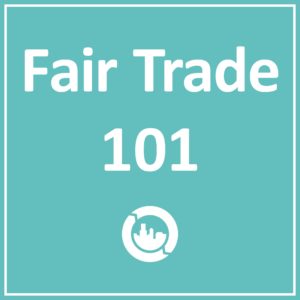How to Host an Ethical Pop Up Market
For the last two years, I have had the pleasure of hosting an ethical Holiday Pop Up market on my university campus with the Fair Trade club. We started this pop up because we all are passionate about ethical businesses and believe in the power of conscious consumerism. We also did it because we crave real-life community experiences that create opportunities for discussion, awareness, and empowerment of local businesses who are committed to high environmental and social standards.

MIIS Fair Trade club member Airon Whitt representing Circle Hands of Uganda.
The process of building up a market from ideation to execution is long and requires a ton of work, but is fulfilling for everyone who is involved. It is so rewarding to know that you have created an event that is much more far reaching than just your campus or friends and family, and it is also an incredible learning experience. I am hoping that my Fair Trade journey at the Middlebury Institute of International Studies can be inspiring to campaigners all over the country and help you host your own pop up market. The more ethical markets that are created, the more awareness of Fair Trade is spread, offering each of you a bigger platform to leverage a wider audience of like-minded community members who share your vision for a more ethical world.
To help you get started with your own pop up market journey, or to just give some inspiration to start a conversation about whether or not a pop up market is right for your campaign, here are some tips that I have learned.
1. FIGURE OUT YOUR WHY

MIIS Fair Trade club member Tangut Defgay welcomes attendees with Fair Trade coffee and sweets as they enter the market.
Don’t host a pop up just because it’s cool to host a pop up – it’s take a HUGE amount of work and money to coordinate all the logistics that go into creating a meaningful and fun event. Do it because it will do something powerful for your community and help create awareness around Fair Trade. If you want to build up or extend the Fair Trade brand, a pop up can help clarify how your campaign views Fair Trade in the context of your community and can be a great way to start conversations that extend much farther than your club or team. It will also help to create buy in for your campaign by your leadership team members and any other club members who get involved.
2. GATHER YOUR TEAM

The Holiday Pop Up Leadership Committee that met weekly for three months to plan the market.
A diverse team full of people who are committed to the cause and passionate for social change is CRUCIAL to successfully executing an event of this size. Form committees, delegate responsibilities to everyone, and let them shine in their roles. This is an opportunity to build resumes, create new contacts, and gain experience that can extend way beyond the actual market – think of this time as investment in yourselves and your skills. Make sure to have weekly meetings and open communication so you can all be on the same page and have a shared vision. These meetings can turn out to be really fun and creative times together, so bring your ideas and enthusiasm!
3. CREATE A BUDGET AND STICK TO IT
This is important not only for an event, but for life. If you don’t know how to create a budget, this is the perfect moment to figure it out because sticking to a budget makes it possible for you to do the stuff you want in life and in business. I recommend using Google sheets so you can communicate with your team in real time to sketch out a budget and track your spending. Our spreadsheet was broken down into costs (what we spent) and revenues (what we earned). In addition, we got funding from our Student Council as well as a local grant and vendor fees. By charging per booth, you can generate enough to cover overhead costs and expenses (like pizza for volunteers!) that pop up throughout the planning period.
4. REACH OUT TO FAIR TRADE COMPANIES

MIIS Fair Trade club member Ruth Lai presenting a vendor with our sponsor form after the event.
We were able to get some awesome donations from companies like Mata Traders, Bead and Reel, Divine Chocolate, Marquet Fair Trade, Seeds to Sew, Circle of Hands Uganda, Trades of Hope, Gallant International, and Fair Trade USA. Our process for donations consisted of reaching out to these companies, explaining what we were trying to do, and asking if they could donate products to support us. Every single company wrote back and we have created impactful relationships with each vendor that can translate into much more impact in the future as well!
5. ANNOUNCE YOUR EVENT TO THE WORLD
Marketing the event should be a top priority. Make sure to tell everyone about your pop up through email newsletters, blog posts, flyers, press releases – we were even featured in the local paper! Take marketing a step further by asking all vendors and donors to share the pop up with their networks. Every mention helps, and collaboration with local stores that share your mission, like Whole Foods or Ten Thousand Villages, will help a lot too.
6. HAVE FUN!
Enjoy all your hard work. Creating an event the unites advocates with brands under one musical and food-filled roof is the best way to create impact, spread Fair Trade goodness throughout your community, and find some great gifts. Take pride in what you’ve created, make sure to snack on some Fair Trade chocolate, and celebrate your achievements.





You must log in to join the discussion. If you are not already a member registering is easy.